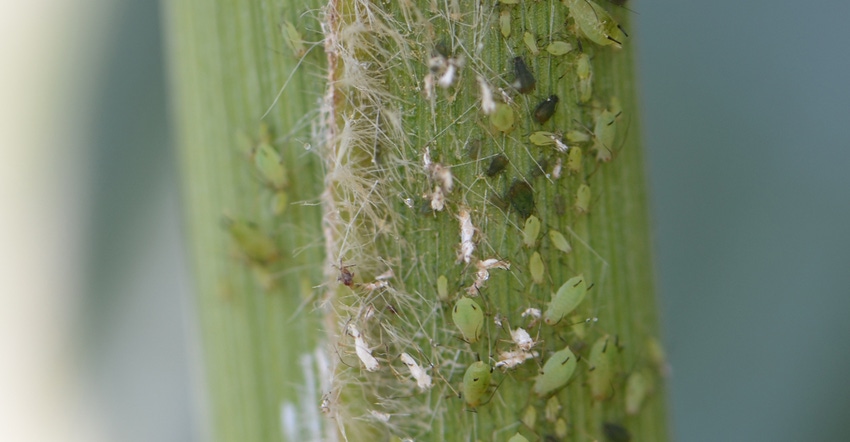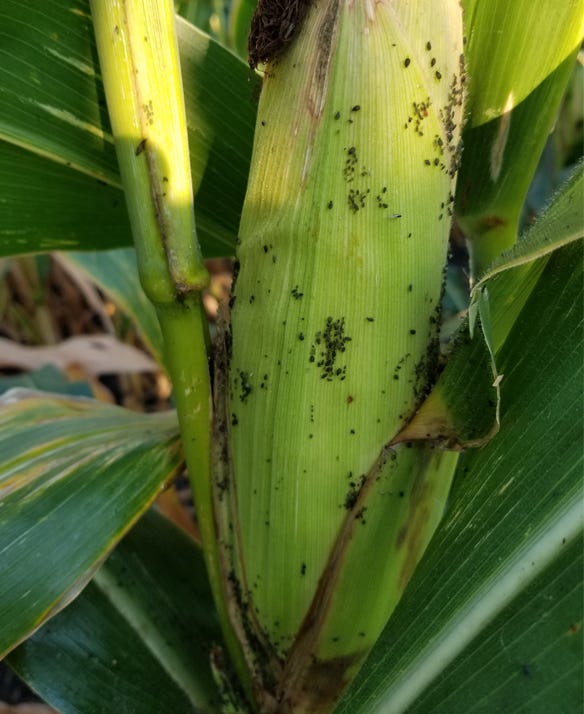August 13, 2018

Since 2010, aphids have been colonizing corn later in the summer and are building up to striking levels in Iowa. They can be found at the base of the stalk, around the ear and sometimes above the ear leaf. Aphids have been sighted in corn again this summer.
Aphids have been confirmed in some cornfields this year beginning in late July, particularly in northeast Iowa. This is about 10 to 14 days earlier than previous growing seasons, says Erin Hodgson, Iowa State University Extension entomologist. Some of these infested fields were sprayed in early August. She noticed aggregated colonies of aphids at the end rows in some fields, but some other areas have aphids throughout the field.
Cornfields can have two aphid species: corn leaf aphid and bird cherry-oat aphid. They are closely related and look very similar in size and color. You can see more than one species in a field and even on a single plant, Hodgson says.
The bird cherry-oat aphid has an orange-red saddle between the cornicles. Other aphid species can also be found, including greenbug and English grain aphid, but are not as common in corn this year. Species identification is not critical for management at this point — an aphid is an aphid.
All aphids have piercing-sucking mouthparts and feed on the sap from the plant. They excrete sugar-rich honeydew that can cover the aboveground portion of plants. The honeydew can promote a sooty mold that interferes with plant photosynthesis.
“We know soybean plants covered with mold and aphids can have serious yield loss, but we don't know the extent of yield reduction caused by aphids in corn,” Hodgson says.
Can you spray insecticide?
“Currently, there are no treatment thresholds for aphids in corn past tasseling,” says Hodgson. “But regular sampling will help you make educated decisions about a foliar application at this time.” She says you should sample fieldwide (30 plants for every 50 acres) to determine the average density.

POLLEN SHED: Although control is not normally required once tassels have emerged, on occasion aphids may interfere with pollination and an insecticide treatment may be warranted.

Consider these factors before deciding to apply an insecticide for aphid in corn:
• Are 80% of the plants infested with aphids or are they aggregated around the field perimeter?
• Are aphids colonizing the ears, or the ear leaf and above?
• How long has the field been infested and is the density increasing?
• Do you see honeydew or sooty mold on the stalk, leaves or ear? Mold can interfere with photosynthesis and interfere with the grain-filling process. Moldy ears could also reduce grain quality and make harvest difficult.
• Are you seeing winged aphids or nymphs with wing pads? This may be a sign of migration out of the field.
• Is the field under drought stress? Dry weather will make amplify potential feeding damage to corn.
• Do you see any bloated, off-color aphids under humid conditions? Natural fungi can quickly wipe out aphids in field crops. Also, parasitized aphids are common to see in corn and are a result of wasp biocontrol.
• What is the corn growth stage? Fields reaching hard dent may be past the point of a justified insecticide.
• What is the expected harvest date? Some insecticides have a 60-day pre-harvest interval. Check the label and calendar.
• Are you able to use high volume and pressure of an insecticide application to reach the aphids? Ideally, small droplets should make contact with the aphids for a quick knockdown. Don't expect residual to protect the corn from fluid feeders.
Typically, fields with more than 500 aphids per plant fieldwide will benefit from application of a foliar insecticide, Hodgson says. “I strongly encourage you to leave an untreated check strip or two in fields that you spray. Try to leave a strip that is a fair comparison to the majority of the field, not just along the field edge. If you decide to treat for aphids in corn, I would like to hear about the yield comparisons. Your pooled data will help me formulate treatment guidelines for the future.”
Source: Iowa State University
You May Also Like




